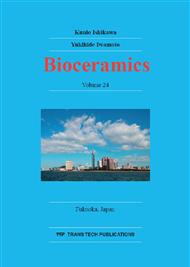[1]
H.E. Achneck, B. Sileshi, R.M. Jamiolkowski, D.M. Albala, M.L. Shapiro, J.H. Lawson, A comprehensive review of topical hemostatic agents: efficacy and recommendations for use, Ann. Surg. 251 (2010) 217-228.
DOI: 10.1097/sla.0b013e3181c3bcca
Google Scholar
[2]
W.R. Wagner, J.M. Pachence, J. Ristich, P.C. Johnson, Comparative in vitro analysis of topical hemostatic agents, J. Surg. Res. 66 (1996) 100-108.
DOI: 10.1006/jsre.1996.0379
Google Scholar
[3]
J.T. Correll, H.R. Prentice, E.C. Wise, Biologic investigations of a new absorbable sponge, Surg Gynecol Obstet 81 (1945) 585-589.
Google Scholar
[4]
F. Xavier, P. Michèle, B. Anne-Marie, L. Sophie, H.D. Solenn, Q. Jérôme, M. Xavier, D.M. Gilbert, G. Julien, Management options for dental extraction in hemophiliacs: A study of 55 extractions (2000-2002), Oral Surg. Oral Med. Oral Pathol. Oral Radiol. Endod. 99 (2005).
DOI: 10.1016/j.tripleo.2004.06.071
Google Scholar
[5]
C.E. Magyar, T.L. Aghaloo, E. Atti, S. Tetradis, Osten, a new alkylene oxide copolymer bone hemostatic material, does not inhibit bone healing, Neurosurgery 63 (2008) 373-378.
DOI: 10.1227/01.neu.0000316859.03788.44
Google Scholar
[6]
T. Wellisz, Y.H. An, X. Wen, Q. Kang, C.M. Hill, J.K. Armstrong, Infection rates and healing using bone wax and a soluble polymer material, Clin. Orthop. Relat. Res. 466 (2008) 481-486.
DOI: 10.1007/s11999-007-0067-5
Google Scholar
[7]
T. Kamide, M. Nakada, Y. Hirota, Y. Hayashi, N. Uchiyama, J.I. Hamada, Skull osteohypertrophy as a complication of bone wax, J. Clin. Neurosci. 16 (2009) 1658-1660.
DOI: 10.1016/j.jocn.2009.03.014
Google Scholar
[8]
B. Sudmann, G. Bang, E. Sudman, Histologically verified bone wax (beeswax) granuloma after median sternotomy in 17 of 18 autopsy cases, Pathology 38 (2006) 138-141.
DOI: 10.1080/00313020600561732
Google Scholar
[9]
Y. Momota, Y. Miyamoto, K. Ishikawa, M. Takechi, T. Yuasa, S. Tatehara, M. Nagayama, K. Suzuki, Evaluation of feasibility of hydroxyapatite putty as a local hemostatic agent for bone, J. Biomed. Mater. Res. Appl. Biomaterial 63 (2002) 542-547.
DOI: 10.1002/jbm.10332
Google Scholar
[10]
J. Tazaki, T. Akazawa, M. Murata, M. Yamamoto, Y. Tabata, R. Yoshimoto, M. Arisue, BMP-2 dose-response and release studies in functionally graded HAp, Key Engineering Materials 309-311 (2006) 965-968.
DOI: 10.4028/www.scientific.net/kem.309-311.965
Google Scholar
[11]
M. Murata, T. Akazawa, J. Tazaki, K. Ito, T. Sasaki, M. Yamamoto, Y. Tabata, M. Arisue, Blood permeability of a novel ceramics scaffold for bone morphogenetic protein-2, J. Biomed. Mater. Res. Appl. Biomaterial 81B (2007) 469-475.
DOI: 10.1002/jbm.b.30686
Google Scholar
[12]
T. Akazawa, M. Murata, T. Sasaki, J. Tazaki, M. Kobayashi, T. Kanno, K. Nakamura, M. Arisue, Biodegradation and bioabsorption innovation of the functionally graded bovine bone–originated apatite with blood permeability, J. Biomed. Mater. Res. 76A (2006).
DOI: 10.1002/jbm.a.30439
Google Scholar
[13]
P. Bickler, J. Brandes, M. Lee, K. Bozic, B. Chesbro, J. Claassen, Bleeding complications from femoral and sciatic nerve catheters in patients receiving low molecular weight heparin, Anesth. Analg. 103 (2006) 1036.
DOI: 10.1213/01.ane.0000237230.40246.44
Google Scholar
[14]
R.G. Hardy, L. Williams, J.M. Dixon, Use of enoxaparin results in more haemorrhagic complications after breast surgery than unfractionated heparin, Br. J. Surg. 95 (2008) 834.
DOI: 10.1002/bjs.6422
Google Scholar
[15]
B. Lawrence, Understanding and evaluating platelet function, Hematology (2010) 387-396.
Google Scholar
[16]
H. Seyednejad, M. Imani, T. Jamieson, A.M. seifalian, Topical haemostatic agents, Br. J. Surg. 95 (10) 1197-1225.
DOI: 10.1002/bjs.6357
Google Scholar
[17]
Y. Kuboki, T. Saito, M. Murata, H. Takita, M. Mizuno, M. Inoue, N. Nagai, A.R. Poole, Two distinctive BMP-carriers induce zonal chondrogenesis and membranous ossification, respectively, geometrical factors of matrices for cell-differentiation, Connect Tissue Res. 32 (1995).
DOI: 10.3109/03008209509013726
Google Scholar
[18]
U. Ripamonti, S. Ma, A.H. Reddi, The critical role of geometry of porous hydroxyapatite delivery system in induction of bone by osteogenin: A bone morphogenetic protein, Matrix 12 (1992) 202.
DOI: 10.1016/s0934-8832(11)80063-6
Google Scholar


